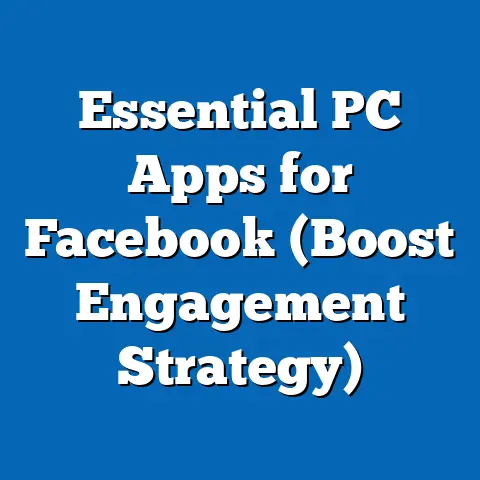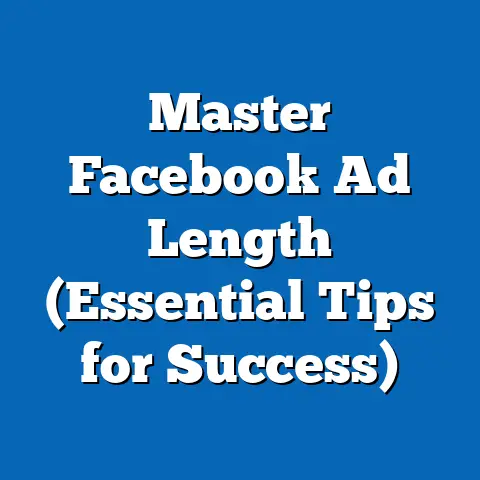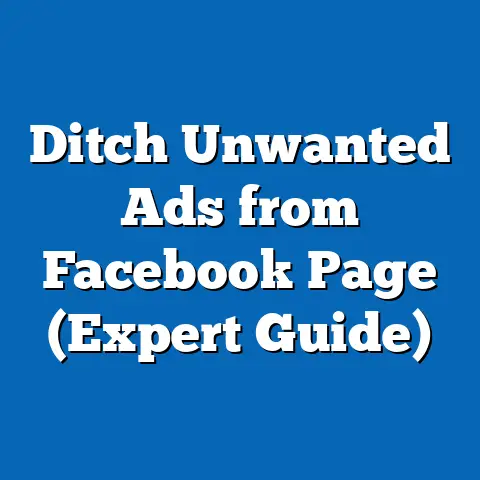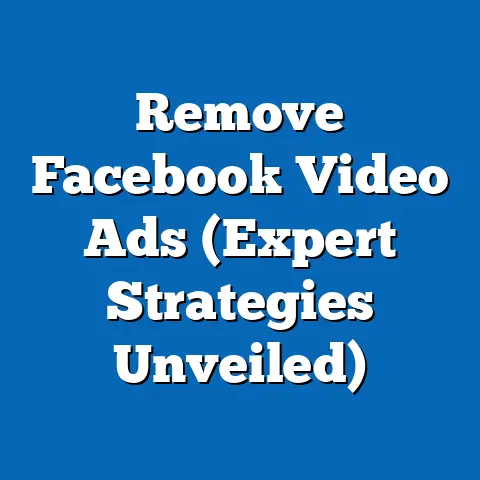Conquering Ad Blocking on Facebook Mobile (Proven Strategies)
The digital advertising landscape is constantly shifting, and one of the most significant trends impacting marketers today is the rise of ad blocking technology. We’re not just talking about a niche corner of the internet; ad blocking has gone mainstream, particularly on mobile platforms. I’ve seen firsthand how this trend can throw a wrench into even the most carefully planned Facebook ad campaigns. As mobile usage continues its relentless climb, exceeding desktop in many regions, the impact of ad blocking on mobile Facebook ads is becoming increasingly hard to ignore.
Statistics paint a clear picture: millions of users are actively employing ad blockers to enhance their browsing experience. This translates to a substantial portion of your potential audience simply not seeing your carefully crafted ads. Think about it – all that time, effort, and budget invested, and your message is essentially invisible to a significant segment of your target market.
In this article, I’m going to delve into the heart of the ad blocking issue on Facebook mobile and equip you with proven strategies to navigate this challenge. I’ll share insights I’ve gained from my own experiences, along with data-backed tactics you can implement immediately to minimize the impact of ad blocking and maximize your ROI. Let’s get started!
Understanding Ad Blocking
Let’s start with the basics. What exactly is ad blocking? In simple terms, ad blocking refers to the use of software or browser extensions that prevent advertisements from displaying on websites and within apps. These tools work by filtering out code and content identified as ads, resulting in a cleaner, faster, and often more private browsing experience.
The Numbers Don’t Lie: Ad Blocker Usage Statistics
To truly understand the scale of the problem, let’s look at some key statistics. While numbers fluctuate, the overall trend is undeniable:
- Mobile Ad Blocking is Growing: Reports consistently show a steady increase in mobile ad blocker adoption. While desktop usage might be plateauing, mobile is where the growth is happening.
- Facebook is a Target: Because Facebook is a primary platform for digital advertising, it’s also a prime target for ad blocking. Users are increasingly employing ad blockers to reduce the number of ads they see while scrolling through their feeds.
- Demographic Trends: Understanding who uses ad blockers is crucial. Data suggests that younger, more tech-savvy users are more likely to employ ad blocking tools. However, adoption is expanding across all age groups as awareness and ease of use increase.
Why Do People Block Ads? Unveiling the Motivations
Understanding the why behind ad blocking is just as important as knowing the what. Users aren’t just blocking ads on a whim; there are underlying reasons driving this behavior. Here are some of the most common motivations:
- User Experience: This is arguably the biggest driver. Intrusive, irrelevant, and poorly designed ads can severely degrade the user experience, making browsing frustrating and slow.
- Speed: Ads, especially those with rich media like videos, can significantly slow down page loading times. Ad blockers eliminate these delays, leading to a faster and smoother browsing experience.
- Privacy Concerns: Many users are increasingly concerned about data tracking and privacy violations. Ad blockers can prevent advertisers from tracking their online behavior, providing a sense of control over their personal information.
- Irritation with Intrusive Ads: Pop-up ads, autoplay videos, and other intrusive ad formats are a major source of frustration for users. Ad blockers offer a way to eliminate these annoyances and enjoy a less disruptive browsing experience.
Takeaway: Understanding the motivations behind ad blocking is crucial for developing effective strategies to overcome it. Focus on improving the user experience, respecting privacy, and creating non-intrusive ads that provide genuine value.
The Impact of Ad Blocking on Facebook Advertising
Now that we understand what ad blocking is and why people use it, let’s examine its direct impact on Facebook advertising. The consequences can be significant, affecting everything from reach and engagement to overall campaign performance.
Reduced Reach and Engagement: The Numbers Game
The most immediate impact of ad blocking is a reduction in reach. When users block ads, your ads simply aren’t displayed to them. This means you’re missing out on a potentially large segment of your target audience. The decrease in reach, in turn, leads to lower engagement metrics, such as clicks, likes, shares, and conversions.
Implications for Brands: A Marketing Reality Check
For brands that rely heavily on Facebook for their marketing strategies, ad blocking can be a serious challenge. It can disrupt carefully planned campaigns, impact sales targets, and force a reassessment of overall marketing budgets. I’ve seen businesses struggle to adapt, sticking to outdated strategies and wondering why their results are declining.
Case Studies: Real-World Examples of Ad Blocking’s Impact
To illustrate the real-world impact of ad blocking, let’s look at a few hypothetical (but realistic) case studies:
- E-commerce Startup: A small e-commerce startup launches a Facebook ad campaign to promote a new product line. However, they fail to account for ad blocking, and their reach is significantly lower than expected. As a result, they miss their sales targets and struggle to gain traction in the market.
- Local Restaurant: A local restaurant runs a Facebook ad campaign to drive reservations. However, many potential customers in their target area use ad blockers, and the restaurant sees a minimal increase in bookings. They end up wasting their advertising budget and failing to achieve their goals.
- Non-Profit Organization: A non-profit organization launches a Facebook ad campaign to raise awareness for their cause. However, because many users are blocking ads, their message doesn’t reach a wide enough audience, and they fall short of their fundraising goals.
These examples highlight the importance of understanding and addressing ad blocking as part of your overall Facebook advertising strategy.
Takeaway: Ad blocking can have a significant impact on Facebook advertising, leading to reduced reach, lower engagement, and missed business goals. It’s crucial to acknowledge this reality and develop strategies to mitigate its effects.
Proven Strategies to Conquer Ad Blocking on Facebook Mobile
Okay, so we’ve established that ad blocking is a real problem. But don’t despair! There are effective strategies you can implement to minimize its impact and still achieve your Facebook advertising goals. Let’s dive into some proven tactics:
1. Creating Engaging and Authentic Content
- Tell a Story: People are naturally drawn to stories. Use your ads to tell a compelling narrative that connects with your audience on an emotional level.
- Focus on Benefits, Not Features: Instead of simply listing the features of your product or service, highlight the benefits it provides to the user. How will it improve their life? Solve their problems?
- Be Authentic: Don’t try to be something you’re not. Be genuine and transparent in your messaging. People can spot inauthenticity a mile away.
Example: Instead of running an ad that says, “Buy our new coffee maker! It has 12 different settings!”, try an ad that tells a story about how your coffee maker helps busy parents start their day with a perfect cup of coffee, giving them the energy they need to tackle their daily challenges.
2. Utilizing Targeting Options Effectively
Facebook’s advanced targeting options are a powerful tool for minimizing ad waste and ensuring your ads reach the right people. By carefully segmenting your audience and personalizing your ads, you can increase relevance and reduce the likelihood of ad blocking.
- Leverage Detailed Targeting: Use Facebook’s detailed targeting options to narrow down your audience based on demographics, interests, behaviors, and more.
- Create Custom Audiences: Upload your existing customer data to create custom audiences of people who are already familiar with your brand.
- Use Lookalike Audiences: Expand your reach by creating lookalike audiences of people who share similar characteristics with your best customers.
Example: If you’re selling fitness apparel, you can target users who are interested in fitness, yoga, or running, and who have purchased similar products in the past.
3. Ad Formats That Bypass Ad Blockers
Certain ad formats are less likely to be blocked than others. Explore the various ad formats available on Facebook and experiment with those that offer a more immersive and engaging user experience.
- Carousel Ads: These ads allow you to showcase multiple images or videos in a single ad unit, providing a more interactive and engaging experience.
- Video Ads: Video ads are highly engaging and can be used to tell a story, demonstrate a product, or provide valuable information.
- Stories Ads: Stories ads are full-screen, immersive ads that appear within Facebook Stories. They are less intrusive than traditional ads and can be highly effective at capturing attention.
Example: A clothing retailer could use a carousel ad to showcase different outfits, a video ad to demonstrate how to style a particular item, or a Stories ad to offer a behind-the-scenes look at their design process.
4. Incorporating User-Generated Content
User-generated content (UGC) is a powerful tool for building trust and engagement. When customers share their experiences with your brand, it adds a layer of authenticity that traditional advertising simply can’t replicate. I’ve found that ads featuring UGC often outperform those with polished, professional content.
- Encourage Customer Reviews: Ask your customers to leave reviews on your Facebook page.
- Run Contests and Giveaways: Encourage users to submit photos or videos of themselves using your products or services.
- Feature Customer Testimonials: Showcase positive customer testimonials in your ads.
Example: A travel agency could run a contest asking customers to submit their favorite vacation photos. The winning photos could then be featured in their Facebook ads.
5. Emphasizing Value and Transparency
Providing clear value in your ads is crucial for reducing ad blocking tendencies. Users are more likely to tolerate ads that offer something of value, such as discounts, exclusive content, or educational material. Transparency is also key. Be upfront about who you are and what you’re offering.
- Offer Discounts and Promotions: Provide exclusive discounts or promotions to Facebook users.
- Share Valuable Content: Share blog posts, articles, or videos that provide valuable information to your target audience.
- Be Transparent About Your Business: Be clear about who you are, what you do, and what you stand for.
Example: A software company could offer a free trial of their software to Facebook users, share blog posts about industry best practices, or highlight their commitment to data privacy.
6. Experimenting with Frequency and Timing
Ad frequency can play a significant role in ad blocking. Bombarding users with the same ad over and over again can lead to ad fatigue and increased ad blocking. It’s important to optimize your ad scheduling and frequency to maintain audience interest without becoming annoying.
- Monitor Ad Frequency: Keep a close eye on your ad frequency metrics in Facebook Ads Manager.
- Rotate Your Ads: Regularly update your ad creative to prevent ad fatigue.
- Experiment with Different Ad Schedules: Test different ad schedules to find the optimal timing for reaching your target audience.
Example: Instead of running the same ad continuously for a week, try rotating between three different ad variations and scheduling them to run at different times of the day.
Takeaway: These strategies provide a multi-faceted approach to conquering ad blocking on Facebook mobile. By focusing on creating engaging content, targeting effectively, utilizing various ad formats, incorporating UGC, emphasizing value and transparency, and experimenting with frequency and timing, you can minimize the impact of ad blocking and maximize your advertising ROI.
Leveraging Facebook’s Tools and Innovations
Facebook isn’t sitting idly by while ad blocking threatens its advertising ecosystem. The platform is actively working to counteract ad blocking by improving ad relevance, transparency, and user experience. As advertisers, we can leverage Facebook’s own tools and innovations to refine our strategies and combat ad blocking.
- Facebook Analytics: This powerful tool provides valuable insights into user behavior, allowing you to understand how people interact with your ads and website. Use this data to optimize your targeting, creative, and overall campaign strategy.
- A/B Testing: This feature allows you to test different variations of your ads to see which performs best. Experiment with different headlines, images, and calls to action to find the combination that resonates most with your audience.
- Audience Insights: This tool provides detailed information about your target audience, including their demographics, interests, behaviors, and more. Use this data to create more relevant and engaging ads.
Example: Use Facebook Analytics to track which types of ads are generating the most engagement. Then, use A/B testing to experiment with different headlines and images for those ads. Finally, use Audience Insights to learn more about the people who are engaging with your ads and refine your targeting accordingly.
Takeaway: Facebook offers a suite of tools and features that can help you combat ad blocking by improving ad relevance, transparency, and user experience. Leverage these resources to optimize your campaigns and minimize the impact of ad blocking.
Building a Community and Fostering Loyalty
Beyond individual ad strategies, building a strong community around your brand on Facebook can be a powerful way to reduce ad blocking tendencies. When users feel connected to your brand and engaged with your content, they’re less likely to block your ads.
- Create a Facebook Group: Start a Facebook group where your customers can connect with each other, share their experiences, and ask questions.
- Run Regular Contests and Giveaways: Host regular contests and giveaways to reward your loyal followers and encourage engagement.
- Offer Exclusive Content: Provide exclusive content to your Facebook followers, such as behind-the-scenes videos, early access to new products, or special discounts.
- Respond to Comments and Messages: Be responsive to comments and messages from your followers. Show them that you care about their opinions and feedback.
Example: A beauty brand could create a Facebook group where customers can share their makeup tips, ask for advice, and participate in discussions about beauty trends. They could also run regular contests and giveaways, offering free products to their most engaged followers.
Takeaway: Building a strong community around your brand on Facebook can foster loyalty and reduce ad blocking tendencies. By creating a space where users feel connected, valued, and engaged, you can minimize the impact of ad blocking and build long-term relationships with your customers.
The Future of Advertising on Facebook in the Context of Ad Blocking
The relationship between mobile advertising and ad blocking is constantly evolving. As technology advances and user preferences change, the future of advertising on Facebook will undoubtedly be shaped by this dynamic.
- AI-Powered Advertising: Artificial intelligence is playing an increasingly important role in digital advertising. AI-powered tools can help advertisers create more relevant and engaging ads, target their audience more effectively, and optimize their campaigns in real-time.
- Privacy-Focused Advertising: As privacy concerns continue to grow, advertisers will need to adopt more privacy-focused advertising strategies. This may include using anonymized data, targeting users based on contextual signals rather than personal information, and providing users with more control over their data.
- Subscription-Based Advertising: Some experts believe that subscription-based advertising models may become more prevalent in the future. This would involve users paying a monthly fee to access ad-free content, while advertisers would pay to have their ads displayed to these subscribers.
Takeaway: The future of advertising on Facebook will be shaped by technological advancements, evolving user preferences, and increasing privacy concerns. Advertisers who are able to adapt to these changes and embrace new strategies will be best positioned for success.
Conclusion
Conquering ad blocking on Facebook mobile is an ongoing challenge, but it’s not insurmountable. By understanding the motivations behind ad blocking, implementing proven strategies, leveraging Facebook’s tools and innovations, building a strong community, and staying ahead of the curve, you can minimize the impact of ad blocking and maximize your advertising ROI.
Remember, the key is to focus on creating engaging content, providing genuine value, and respecting user privacy. As the digital advertising landscape continues to evolve, it’s crucial to adapt your strategies and embrace new approaches to reach your target audience.
Call to Action
Now it’s your turn! What strategies have you found most effective for combating ad blocking on Facebook mobile? Share your thoughts and experiences in the comments below. Let’s learn from each other and build a stronger, more effective advertising community!





